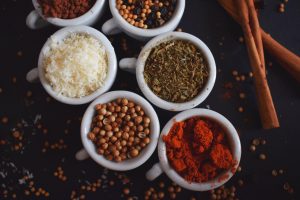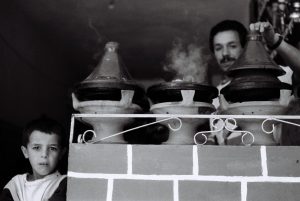Moroccan food

Moroccan cooking is characterized by many influences which tell, through Moroccan food, the long history of the North African country made of colonizers and immigrants with flavours recalling the Middle East, Andalusia and France. Berber cuisine is still alive in dishes such as couscous and tagine: the first is a dish made of grains of semolina seasoned with vegetables and meat whereas the second is a stew which takes its name from the terracotta terrine in which it is cooked on the grill and composed of lamb, fish or vegetables.
In addition, dates and dried fruits are an integral part of the Moroccan diet, especially in the tagine, and are essential during Ramadan, introduced by Harira, Morocco’s most important soup, made of tomato with chickpeas, meat, lentils and small noodles. Moroccan salads can be either cooked or raw. The raw salad consists of tomatoes, cucumbers, onions, green pepper and cilantro while Baalouk, Bakoula and Choukchouka. Are made of different combinations of vegetables and spices cooked all together in a pan. If you are wondering, where to eat in Morocco, know that you can choose between various types of restaurants, including classic and grilled ones, where you can taste tasty dishes at a low cost.
In the markets, you’ll find many stalls selling bread, candied lemons, dried fruit, soups, stews, and meat skewers. The new cities offer a wide variety of restaurants, from Moroccan to international, from pizzerias to fast food.
Moroccan food:
Spices

Olives also play an important role in Moroccan cooking, citrus fruits, coffee and of course spices, such as cumin, turmeric, ginger and pepper which are used in every dish and are combined with cinnamon, paprika, Sahara chillies and saffron. Very often you will also taste dishes enriched with cardamom, in this case, we are talking about sweets… What about parsley and coriander, always bought together in Moroccan souks, and Ras el Hanout, a mix of 20-40 different spices mixed by shopkeepers according to their own traditional recipe and widely used for cooking.
Must try

Couscous, a fine semolina grain, traditional Moroccan dish, served with lamb. Pastilla or Bisteeya is a filo pastry filled with shredded chicken or pigeon. They mix it with eggs, cinnamon, raisins and chopped almonds. Tagine is a stew traditionally cooked over a smoking charcoal fire in an earthenware pot: they come in many combinations such as beef with plums, lemon chicken, lamb with dates, Kefta, that is meatballs, with eggs, seafood, or just vegetables. Tanjia is made of spiced beef or lamb, tied with paper and string and brought to the local hammam, the oven, where the pan is buried under the embers and left to cook slowly for a couple of hours. Harira is a traditional Berber soup served as an appetizer and composed of tomatoes, lentils, onion, Moroccan spices and chickpeas. Along the Atlantic coast enjoy fresh produce and choose from sea bream, oysters, shrimp and lobster.
Cooking classes in Morocco
During your stay in Morocco, you will probably be fascinated by the alchemy of scents, flavours and traditions of Moroccan food, so you need to take part in a short cooking class and then recreate the atmosphere and flavours for your friends and family back home, Discover the secrets of spices, learn ancient techniques and follow the advice of real chefs to make excellent tagine, Diffa, couscous rather than excellent desserts or capture the art of mint tea, a true symbol of Moroccan culture, there are many cooking schools you can choose from during your stay and learn how to cook delicious traditional dishes in the enchanting setting of the riads that often host these workshops.
What do you eat in Morocco?
The Maghreb cuisine, considered the best oriental cuisine, combines refined legumes, fruits, fish, meat and spices.
The national dish is couscous, finely ground and cooked semolina that usually accompanies a stew of lamb and vegetables. It is served with a very spicy sauce called harissa.
Another very common dish is tajine, an excellent stew of meat or fish and vegetables flavoured with herbs and spices; it takes its name from the container in which they cook it. It is a low terracotta dish with a high conical shaped lid. Some are very simple, whereas in others you can add olives or eggs, prunes and almonds or other dried fruits.
Harira is a soup made of lentils, onions, tomatoes, other vegetables, veal and mutton. The pastry is good but very sweet; it can be annoying because of the great quantity of sugars and syrups used. A Berber speciality is M’choui, a whole lamb roasted in the open air and seasoned with saffron and hot pepper. Usually, with the heart and the liver, they prepare it in skewers. Also, locals often cook it on festive occasions.



